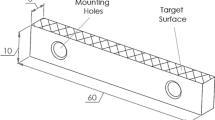Abstract
The present study investigates the simultaneous effect of part building orientation (along the X, Y, and Z axis) and raster angle (0°, 30°, 60°, and 90°) on surface roughness, tensile strength, flexural strength, consumption of model, support material, and building time of acrylonitrile butadiene styrene (ABS) test specimens fabricated by fused deposition modeling (FDM) process. Mechanical properties and surface roughness show a strong anisotropic behavior for the parts. For parts built with the X or Y orientations and 30° or 60° raster angle, pulling of fiber and a small amount of necking along with tearing are observed, which are responsible for higher strength. Post-built treatment of the parts with cold vapors of dimethyl ketone resulted in an immense improvement in surface finish. Exposing the parts in cold vapors turns the surfaces to a soft/mushy-like state due to the weakening of the secondary bonds, and the minor flow of polymer layers fills the cavity region between the adjacent layers and helps in improving the surface finish after the treatment.
Similar content being viewed by others
References
Gurrala PK, Regalla SP (2014) Part strength evolution with bonding between filaments in fused deposition modelling. Virtual Phys Prototyp 9(3):141–149
Sood AK, Equbal A, Toppo V, Ohdar RK, Mahapatra SS (2012) An investigation on sliding wear of FDM built parts. CIRP J Manuf Sci Technol 5:48–54
Sun Q, Rizvi GM, Bellehumeur CT, Gu P (2008) Effect of processing conditions on the bonding quality of FDM polymer filaments. Rapid Prototyp J 14(2):72–80
Sood AK, Ohdar RK, Mahapatra SS (2010) Parametric appraisal of fused deposition modelling process using the grey Taguchi method. Proc Inst Mech Eng B J Eng Manuf 224(1):135–145
Alexander P, Allen S, Dutta D (1998) Part orientation and build cost determination in layered manufacturing. Comput Aided Des 30(5):343–356
Pilipović A, Raos P, Šercer M (2009) Experimental analysis of properties of materials for rapid prototyping. Int J Adv Manuf Technol 40:105–115
Xu F, Loh HT, Wong YS (1999) Considerations and selection of optimal orientation for different rapid prototyping systems. Rapid Prototyp J 5(2):54–60
Thrimurthulu K, Pandey PM, Reddy NV (2004) Optimum part deposition orientation in fused deposition modeling. Int J Mach Tool Manu 44:585–594
Byun HS, Lee KH (2005) Determination of the optimal part orientation in layered manufacturing using a genetic algorithm. Int J Prod Res 43(13):2709–2724
Es-Said OS, Foyos J, Noorani R, Mendelson M, Marloth R, Pregger BA (2000) Effect of layer orientation on mechanical properties of rapid prototyped samples. Mater Manuf Process 15(1):107–122
Noriega A, Blanco D, Alvarez BJ, Garcia A (2013) Dimensional accuracy improvement of FDM square cross-section parts using artificial neural networks and an optimization algorithm. Int J Adv Manuf Technol 69(9):2301–2313
Vijayaraghavan V, Garg A, Lam JSL, Panda B, Mahapatra SS (2015) Process characterisation of 3D-printed FDM components using improved evolutionary computational approach. Int J Adv Manuf Technol 78(5):781–793
Anitha R, Arunachalam S, Radhakrishnan P (2001) Critical parameters influencing the quality of prototypes in fused deposition modelling. J Mater Process Tech 118:385–388
Pérez CJL (2002) Analysis of the surface roughness and dimensional accuracy capability of fused deposition modelling processes. Int J Prod Res 40(12):2865–2881
Ahn D, Kweon JH, Kwon S, Song J, Seokhee L (2009) Representation of surface roughness in fused deposition modeling. J Mater Process Tech 209:5593–5600
Sood AK, Ohdar RK, Mahapatra SS (2010) Parametric appraisal of mechanical property of fused deposition modelling processed parts. Mater Des 31:287–295
Gurrala PK, Regalla SP (2014) Multi-objective optimization of strength and volumetric shrinkage of FDM parts. Virtual Phys Prototyp 9(2):127–138
Pandey PM, Reddy NV, Dhande SG (2003) Improvement of surface finish by staircase machining in fused deposition modeling. J Mater Process Tech 132:323–331
Galeta T, Raos P, Somolanji M (2012) Impact of structure and building orientation on strength of 3D printed models. KGK-Kautschuk Gummi Kunststoffe 65(10):36–42
Krolczyk G, Raos P, Legutko S (2014) Experimental analysis of surface roughness and surface texture of machined and fused deposition modelled parts. Tehnicki Vjesnik - Technical Gazette 21(1):217–221
Boschetto A, Giordano V, Veniali F (2013) Surface roughness prediction in fused deposition modelling by neural networks. Int J Adv Manuf Technol 67(9):2727–2742
Boschetto A, Bottini L (2014) Accuracy prediction in fused deposition modeling. Int J Adv Manuf Technol 73(5):913–928
Rahmati S, Vahabli E (2015) Evaluation of analytical modeling for improvement of surface roughness of FDM test part using measurement results. Int J Adv Manuf Technol 79(5):823–829
Galantucci LM, Lavecchia F, Percoco G (2009) Experimental study aiming to enhance the surface finish of fused deposition modeled parts. CIRP Ann Manuf Techn 58:189–192
Galantucci LM, Lavecchia F, Percoco G (2010) Quantitative analysis of a chemical treatment to reduce roughness of parts fabricated using fused deposition modeling. CIRP Ann Manuf Techn 59:247–250
Percoco G, Lavecchia F, Galantucci LM (2012) Compressive properties of FDM rapid prototypes treated with a low cost chemical finishing. Res J Appl Sci Eng Technol 4(19):3838–3842
ASTM D638-02 (2002) Standard test method for tensile properties of plastics. ASTM International, West Conshohocken
ASTM D790-02 (2002) Standard test methods for flexural properties of unreinforced and reinforced plastics and electrical insulating materials. ASTM International, West Conshohocken
Garg A, Bhattacharya A, Batish A (2016) On surface finish and dimensional accuracy of FDM parts after cold vapor treatment. Mater Manuf Process 31(4):522–529
Chapman B, Desai S, Muraoka M, Vidolova T (2014) Investigating methods of prototyping with ABS. https://benchapman4.files.wordpress.com/2014/05/teamabs_guidereport.pdf. Accessed 29 March 2016
Garg A, Bhattacharya A, Batish A (2015) Failure investigation of fused deposition modelling parts fabricated at different raster angles under tensile and flexural loading. Proc Inst Mech Eng B J Eng Manuf. doi:10.1177/0954405415617447
Author information
Authors and Affiliations
Corresponding author
Rights and permissions
About this article
Cite this article
Garg, A., Bhattacharya, A. & Batish, A. Chemical vapor treatment of ABS parts built by FDM: Analysis of surface finish and mechanical strength. Int J Adv Manuf Technol 89, 2175–2191 (2017). https://doi.org/10.1007/s00170-016-9257-1
Received:
Accepted:
Published:
Issue Date:
DOI: https://doi.org/10.1007/s00170-016-9257-1




